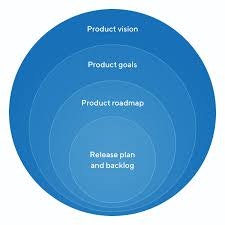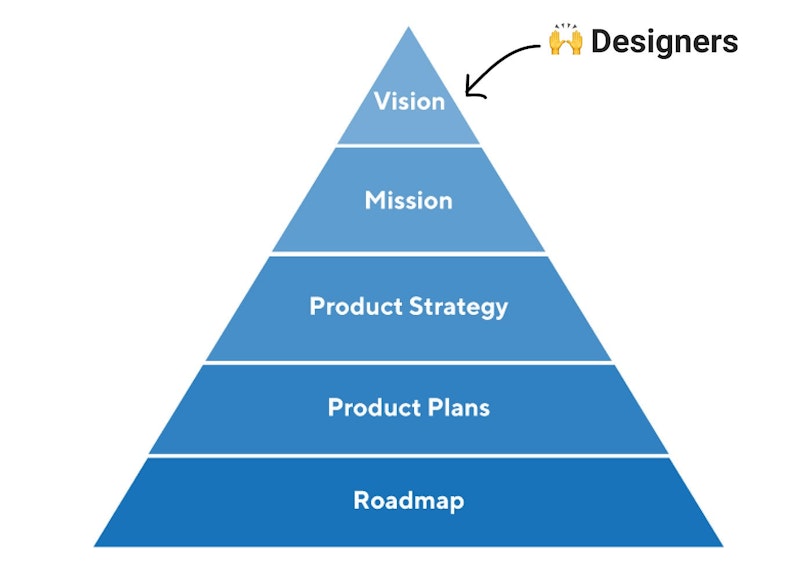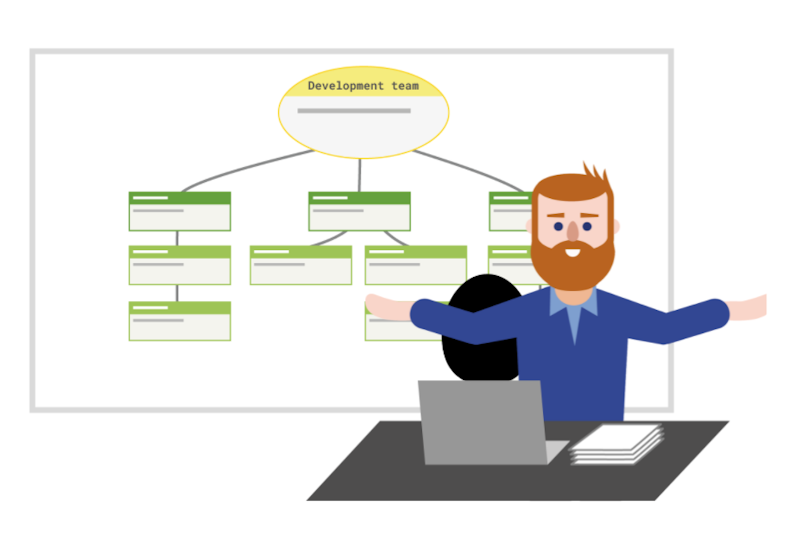What is Product Vision in Scrum? (With Examples)
Introduction:
You may wonder how top-performing teams consistently deliver outstanding results. The key often lies in a framework called Scrum.
But what exactly is Scrum, and why should you care?
At its core, Scrum is an agile project management approach that revolutionizes how teams work together. It's a practical, hands-on method that can transform your team's productivity and collaboration.
While Scrum has its roots in software development, don't let that limit your thinking. Its principles can be applied to virtually any type of teamwork including UX. That's why it's gained such widespread popularity across industries.
In this article, we'll closely examine a crucial aspect of Scrum:
The Product Vision.
You'll discover how this concept can improve your projects and drive your team towards shared goals. So, without further ado, let's get started!
Need help with your product vision? Consider joining a product vision workshop.
Importance of Product Vision in Scrum

A clear, compelling Product Vision is a crucial element of Scrum. It guides your entire team towards a common goal.
Product vision is about the big picture:
What you're building and why it matters.
So, what makes a Product Vision truly effective?
A well-crafted Product Vision answers the key questions:
Who are we serving? (Your target customers)
What problems are we solving? (Their needs or jobs to be done)
What makes our solution special? (Your unique value proposition)
By aligning your Scrum Team and stakeholders around these critical points, a strong Product Vision becomes a simple yet extremely effective tool for project success. It helps you build the right thing, for the right reasons.
Understanding Product Vision in Scrum
The most important thing that keeps a Scrum team focused and motivated is the Product Vision. Let's see what this crucial element means for your project's success.
What Exactly is a Product Vision?

In layman's terms, the product Vision is a clear, concise statement that captures the essence of what you're building and why it matters.
A well-crafted Product Vision paints a picture of the value you're creating and who will benefit from it.
The best Product Visions have the power to get your team excited about the journey ahead.
And here's a key point:
While the Product Owner owns the vision, it's a collaborative effort. Your entire Scrum team and stakeholders should have a hand in shaping it.
What Makes a Product Vision Effective?
An effective product Vision has several key characteristics:
1. It's compelling and aspirational:
It should make people want to join your cause.
2. It aligns with business strategy:
Use language that connects to your organization's goals.
3. It's transparent and concise:
Keep it simple and accessible to everyone.
4. It's human and relatable:
Connect your product to the customers who'll use it.
5. It's unambiguous:
It should help you say "no" to ideas that don't fit.
Remember, your Product Vision isn't set in stone. It can and should evolve as you learn more about your market and opportunities.
Let's consider an example:
Take Microsoft's vision: "To empower people through great software, any time, any place, or any device." It's short, and clear, and paints a picture of the value they aim to create.
A strong Product Vision is your roadmap to building something truly impactful. So, what's your Product Vision?
How to Create an Effective Product Vision?
Ready to develop a Product Vision that truly resonates?
Let's explore how to crreate one that will energize your team and guide your project to success.
Starting Your Vision Statement
One popular approach is using a template like this:
For [target customers], who [customer need], our [product/service name] is a [product category] that [key benefit/reason to buy]. Unlike [competitor], our product [key differentiator].
This template can help you organize your thoughts, but it's just a starting point. Your vision should feel authentic to your project and team.
Real-World Examples
Let's look at some inspiring Product Vision examples:
1. “Enable teams globally to collaborate seamlessly, enhance productivity, and achieve remarkable results through the comprehensive and intuitive project management platform, ensuring work is efficient and enjoyable.”
2. "Revolutionize global education by offering an accessible, personalized, and captivating e-learning experience for individuals of all ages and backgrounds, helping them reach their full potential and create a brighter future”
These examples show how a vision can be both aspirational and specific about the value they're creating.
Learn how to make a strong vision statement with our product vision statement article.
Crafting Your Vision
When writing your Product Vision, consider these approaches:
1. The Aspirational Phrase:
A simple, inspiring statement that captures your product's purpose. For example: "By creating safer roads in our cities, we believe more children who travel to school as pedestrians will arrive safely every day."
2. The Hypothesis Statement:
"We believe that by doing X for customer Y, we'll create outcome Z."
3. The Detailed Template:
"For customer [persona V], product [name W], will help them [job to be done or primary goal X], (optionally [in context or with differentiator Y]), so that [impact Z]."
Key Tips:
Keep it concise: Your vision should be easy to understand and remember.
Make it inspiring: It should motivate your team and stakeholders.
Align with goals: Ensure it reflects your product and business objectives.
Be flexible: Your vision can evolve as you learn more about your market and customers.
Remember, your Product Vision is more than just words - it's the spark that ignites your team's passion and drives your project forward. Take the time to craft it carefully, and you'll set the stage for incredible success.
What vision will guide your next great project?
Tools and Techniques for Crafting Your Product Vision
Let's take a look at some powerful tools and techniques that can help you shape a vision that truly resonates
1. The Vision Board:
A vision board helps you get your entire Product Vision laid out before you in a single, compelling image. This visual tool helps you capture the core of your product, its target audience, and its unique value proposition all in one place.
To create your Vision Board, start by answering these key questions:
Who are your target customers?
What are their needs or pain points?
How does your product solve these problems?
What makes your solution unique?
By mapping out these elements visually, you'll gain clarity and alignment on your Product Vision.
2. The Elevator Pitch: Communicating Your Vision Succinctly
Can you explain your Product Vision in the time it takes to ride an elevator?
That's the challenge of the Elevator Pitch technique. This exercise forces you to distill your vision into its most essential elements, making it easy to communicate and remember.
Here's a simple template to get you started:
"For [target audience] who [need or problem], our [product] is a [category] that [key benefit]. Unlike [competitors], we [unique differentiator]."
The goal here is clarity and impact.
3. Involve Stakeholders to Build a Shared Vision
Creating a powerful Product Vision is a collaborative effort. Involving your stakeholders from the get-go ensures your vision aligns with broader business goals and resonates with those who'll bring it to life.
These stakeholders may include:
Executive leadership
Marketing and sales teams
Customer support representatives
End-users or customer representatives
Each of these groups brings a unique perspective that can enrich your Product Vision. By involving them early and often, you're not just creating a vision - you're building buy-in and enthusiasm for your product's future.
Try attending a vision workshop where stakeholders can contribute their ideas and concerns. Use techniques like dot voting or affinity mapping to find common threads and priorities.
Product Vision in Action
A well-crafted Product Vision can transform your entire Scrum project.
Let's dive into how this crucial element guides your team and keeps your project on track.
How Product Vision Guides the Scrum Team
Here's how your product vision works in practice:
1. Prioritisation Made Easy:
With a clear vision, your team can quickly assess which tasks align with the bigger picture. Is that new feature request in line with your vision? If not, it might need to take a back seat.
2. Better Decision-Making:
When faced with tough choices, your team can refer back to the Product Vision. It helps answer questions like, "Does this decision bring us closer to our goal?"
3. Motivation:
A compelling vision reminds your team why their work matters. It can help you create something valuable and impactful.
4. Alignment:
A good product Vision ensures everyone's efforts are consistently directed towards the same end goal.
Role of the Product Owner in Maintaining the Vision

As a Product Owner, you're the guardian of the Product Vision. It's your job to keep it alive, relevant, and at the forefront of every decision.
Here's how you can do this:
1. Communicate Consistently:
Make the Product Vision a part of your daily conversations. Reference it in sprint planning, backlog refinement, and team discussions.
2. Bridge Business and Development:
You're the link between stakeholders and your Scrum team. Ensure that business goals align with the Product Vision.
3. Evolve the Vision:
Markets change, customer needs shift. As a Product Owner, you need to be alert to these changes and adapt the Product Vision when necessary.
4. Defend the Vision:
Sometimes, you'll face pressure to deviate from the vision. Always keep the long-term goals in mind.
5. Inspire and Motivate:
Use Product Vision to ignite passion in your team. Help them see how their work contributes to the bigger picture.
By effectively maintaining and communicating the Product Vision, you're not just managing a project - you're leading your team towards creating something truly impactful.
Make your strategy sessions better with our strategy workshop exercises.
What is the Product Goal and How is it different from product vision in scrum?

The product goal is another crucial element in Scrum. It's a clear description of where your product is heading - its future state.
The Product Goal is basically a target that gives your Scrum Team focus and a way to measure progress.
Here's what makes the Product Goal unique:
- It's Singular:
There's only a single Product Goal at a time.
- It's Flexible:
There's no set format or timeframe.
- It's Decisive:
You either achieve it or abandon it before moving to the next one.
Why Does the Product Goal Matter?
You might be wondering, "Can't we just work on features and let the product evolve?"
Here's why having a Product Goal is so crucial:
1. It provides focus:
With a clear goal, your team can prioritize what matters.
2. It measures progress:
You can track how close you are to achieving your product's next big milestone.
3. It aligns the team:
Everyone understands what they're working towards, beyond just completing tasks.
4. It connects to business strategy:
It ensures your product development aligns with broader organizational goals.
Difference Between Product Vision and Product Goal:

While Product Vision is the ultimate destination on a long journey, yourProduct Goal is the next major stop on that journey.
Product goal is more concrete and immediate.
Here's a quick breakdown:
Product Vision:
Long-term and aspirational
Typically remains stable over time
Inspires and motivates the team
Aligns with overall business strategy
Product Goal:
Medium-term and actionable
Can change as you achieve milestones
Provides clear direction for upcoming work
Bridges vision and sprint-level tasks
1. Scope and Specificity
Your Product Vision in Scrum is broad enough to include various potential features and directions your product might take. The Product Goal, however, narrows this down to a specific, achievable target.
For instance, your Product Vision might be "To revolutionize how teams collaborate remotely." A corresponding Product Goal could be "Implement a real-time document editing feature with integrated video chat by Q3."
2. Measurement and Achievement
While a Product Vision is often difficult to measure directly, a Product Goal should be something you can achieve or miss.
3. Timeframe and Flexibility
Your Product Vision typically remains stable over a long period, possibly even throughout the entire life of your product.
4. Role in Decision-Making
Both elements play crucial roles in decision-making, but at different levels:
Product Vision helps with high-level strategic decisions. It's your reference point when considering major pivots or new feature sets.
Product Goal guides tactical decisions. It helps you prioritize which features to develop next and what to include in your Product Backlog.
How Product Vision and Product Goal Complement Each Other in Scrum?
1. Vision Inspires, Goal Directs:
Your Product Vision paints an inspiring picture of the future, while your Product Goal provides a concrete target to aim for.
2. Long-term Meets Short-term:
The vision gives you a long-range view, while the goal breaks this down into manageable chunks.
3. Stability and Flexibility:
Your vision remains relatively stable, providing consistency, while goals can adapt to changing circumstances, ensuring agility.
4. Motivation and Measurement:
The vision keeps your team inspired, while goals offer clear metrics to track progress.
Measuring Progress: Keeping Your Scrum Team on Track

Setting goals is just the start - the real magic happens when you track progress. Here's how to measure your journey towards Product Goal achievement:
1. Define Clear Metrics:
Identify key performance indicators (KPIs) that directly relate to your goal. These could be user engagement rates, conversion percentages, or feature adoption metrics.
2. Use Visual Tools:
Employ burndown charts, sprint backlogs, or kanban boards to visualize progress. These Scrum artifacts can help your team stay motivated and aligned.
3. Regular Check-ins:
Make goal progress a regular topic in your sprint reviews and retrospectives. This keeps the Product Goal front and center in your team's mind.
4. Celebrate Milestones:
Acknowledge when you hit important markers on the way to your goal. This boosts morale and maintains momentum.
5. Learn from Setbacks:
If progress is slower than expected, use it as a learning opportunity. What obstacles are you facing? How can you adapt?
6. Communicate Widely:
Share progress updates with stakeholders. This transparency builds trust and can provide valuable external perspectives.
By setting thoughtful Product Goals and diligently measuring progress, you're not just managing a project - you're steering your product toward success. Remember, in Scrum, it's not just about working hard, but about working smart toward clear, impactful objectives.
How will you set and measure your next Product Goal to bring your Product Vision to life?
Wrapping Up
In the fast-paced world of product development, it's easy to get lost in the details. That's where Product Vision and Product Goals in Scrum come in. They provide the clarity and direction needed to complete complex projects successfully.
Your Product Vision keeps your team inspired, even when faced with challenges.
In Scrum, success is all about creating value. Product Vision and Product Goals, can help you keep your vision clear and your goals smart.
What vision will you set for your next project? How will you translate that into impactful goals? The power to shape the future of your product lies in your hands. Create a strong product vision and watch your Scrum projects soar to new heights.
FAQs:
Is product vision mandatory in Scrum?
While not officially part of the Scrum framework, many Scrum experts consider the product vision crucial. Ken Schwaber, a co-creator of Scrum, states that a vision and a Product Backlog are the minimum requirements to start a Scrum project.
Who creates product vision?
In Scrum, the Product Owner is tasked with creating, managing, and owning the product vision.
What is the product goal in Scrum?
The product goal in Scrum describes the future state of the product. It serves as a target for the Scrum Team to plan towards and sits at the top of the Product Backlog.
What is product vision in scrum?
In Scrum, a product vision is a brief statement that sums up the product's purpose, target audience, key features, and long-term development goals.
What is Agile vision?
Agile vision is a succint, inspiring statement that outlines what a team or organization aims to achieve in the future. An Agile product vision statement explains the reason for creating a product, who it's designed for, and what sets it apart from others.





